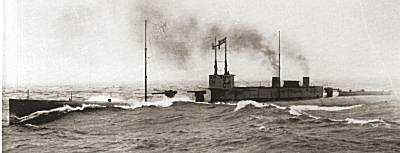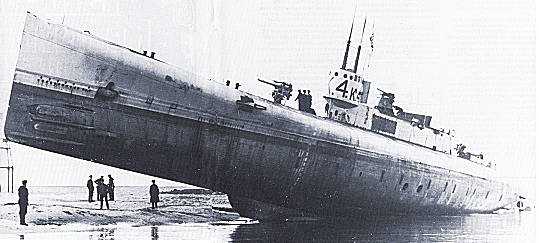back to
homepage & photographs
Page 1.
I 2.
I
3. I
4. I
5. I
6. I
Tasks
2. My End's Diving -
What the Hell is Your End Doing?
It is on record that on June 1, 1913 the late Lord Fisher, former First Sea Lord, addressed a comment to Vice-Admiral Sir John Jellicoe - "The most fatal error imaginable would be to put steam engines in a submarine."
Whatever Fisher might have thought, the Admiralty produced a class of submarines of revolutionary design and had them laid down in secret.
The thought behind the drawings was that there should be craft capable of keeping up with the battle fleet and the vessels were to be the fastest, heaviest and largest submarines anywhere in the world. They actually proved so fast that no submarine of the 1939-45 war could have kept up with them.
Rather more than half the class survived to be scrapped. The others wrote their own tale of calamity.
 |
In all, 17 of these boats entered service between August 1916 and May 1918. They were driven on the surface by steam engines and aft of their conning towers they carried twin retractable funnels. The idea was that when the diving klaxon sounded the funnels were swung into special housings, the furnaces dampened down and the boat dived.
Little wonder that their crews, particularly the stokers, complained bitterly about the heat. Not even Vickers at Barrow, who constructed K3, K4, K8, K9, K10 and K17 could escape the woeful tale of accident and disaster written by the boats.
K4 was sunk in collision with K6 in January 1918. K17 was sunk in collision with HMS Fearless, also in January 1918 and even K19, which was finished as the M2, was sunk on exercise in January 1932. The remainder of the Barrow-built craft survived to be broken up in the early 1920s.
No class of warship in the Royal Navy or any other navy suffered such calamities as the Ks. They were involved in 16 major accidents and any number of minor mishaps. One, the K13 sank on her trials in the Gareloch and her salvage was a feat for the day.

Three were lost in collisions, one sank in harbour, another disappeared; and while the loss of life was appalling the escapes from death were the most remarkable in the Submarine Service.
The boats themselves were suspected, hated and argued about. Men are known to have gone to extreme lengths to avoid service in them and they earned the name of Suicide Club.
Intended as a spearhead for the Grand Fleet and a spearhead possessing great speed and power only one K-class submarine ever engaged the enemy, hitting a U-boat amidships with a torpedo that failed to explode.
Experts disagreed on their design, some condemning it as obsolete even before the boats were built. Others maintained that continued use in the face of a whole chapter of accidents typified the Flanders trench war thinking of the Army of 1914-18.
Others regarded the boats as brilliantly conceived and years ahead of
their time.
Only one of the disasters to the class received public attention because
of wartime censorship.
Although so critical of steam propulsion for them even the great Jackie Fisher believed in Fleet submarines. He agreed that a fast battle fleet accompanied always by submarines under all circumstances would possess overwhelming fighting advantages. The Fleet wanted 21 knots and the 21-knot submarines were urgently required.
There was one eye on the Germans who had vastly superior skill in
designing and building diesel engines.

The design combination gave the Ks a diesel engine, two steam turbines, and four electric motors.
The original intention had been to seal the boiler room off on diving because no men could have lived in it. But Vickers, the builders, introduced a communicating passage so that men would not be cut off from the forward or after compartments. It had three guns and ten 18-inch torpedo tubes, two of them on the funnel super-structure for surface use at night.
Vickers were asked for their earliest delivery dates and costs for two or four K-class authorised in May 1915. They were also told that construction work should be carried out in the utmost secrecy.
Vickers replied very quickly and on June 18, 1915, the Admiralty gave them an order for two boats K3 and K4 each to. cost about £300,000 per boat. Portsmouth Dockyard got the orders for K1 and K2.
The K-class was born.

There was a portent of bad luck when K4 went aground in Walney Channel
during trials and in case you should think that Barrow never put a
submarine on the sand before Repulse made a name for herself at her
launching note the picture, produced from Vickers' photographic
archives.
K1, K4 and the Devonport-built K6 were also all lost in collisions.
From: http://www.submariners.co.uk/Dits/Articles/kclass.htm
Top
www.interactive-learning.com.au